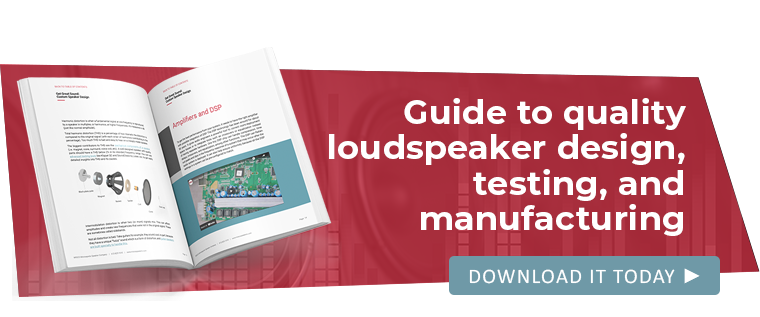OEM Speaker Enclosure Assembly & Final Testing Explained
When designing and manufacturing a loudspeaker, small details can make a big difference. Getting things exactly right requires multiple tests at different points in the process.
MISCO’s video series “Designing & Building a Loudspeaker” covers all parts of manufacturing, from the initial design to selecting the right components and building and testing the driver. This final blog in the series covers putting a driver into an enclosure and testing the finished product.
This five-part video series gives a behind-the-scenes view following the construction of one 5.25” subwoofer, but the principles apply broadly to almost any speaker project. You can find all 5 videos in this playlist.
Speaker Enclosure Assembly
Once the driver passes end-of-line and Klippel testing, it is ready to be installed into the enclosure (for this speaker, it’s a ported enclosure). The parts used in this example are:
- A 3.16 cubic inch MDF (medium-density fiberboard) enclosure
- A plastic port allows the enclosure to be tuned to about 65 Hz
- The lead set has connectors on one end going to the subwoofer and a mini-fit connector on the other to connect to the customer’s wire harness
- Dacron polyfill
- And, of course, the driver that has been built and tested
Step one is installing the lead set into the box. The ends connecting to the speaker are led in first, and the ingress hole from the lead set is covered with hot melt (hot glue) from the inside to preserve the external appearance. Soft Dacron polyfill is placed in the bottom of the enclosure to keep any vibrations at bay.
Next, the plastic port snugly fits into the enclosure, being locked into place by a bead of adhesive. The internal lead ends are then connected to the subwoofer driver, ensuring the polarity of the wires is correct before being slid into place and screwed into the enclosure. With that, the subwoofer system is complete and ready for final testing.
Final Testing
A unique aspect of MISCO is the level of testing we do for all drivers before they are put into their enclosures. To be as thorough as possible, we also test the entire finished speaker because an enclosure can significantly impact a speaker's sound.
What we’re looking for at this point is to make sure we haven’t reversed the polarity, there are no air leaks, no loose screws–nothing that would cause it to sound anything other than how the customer is expecting. The testing also confirms the final impedance curve and frequency response curve.

While this video series focused on the design and manufacturing of a specific product, the steps we took are very common across most of our products. If you have any more questions for our team after this series, don’t hesitate to reach out to us.

